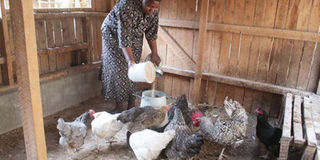Diary of a poultry farmer: Step-by-step diagnosis for a drop in egg production

Farmer, Nancy Mumenya feeds her kuroiler chicken at her farm in Kabachia, Nakuru. Light management throughout the life cycle of layers will determine the age at which a hen starts laying eggs, the number and size of eggs and the consistency of laying throughout life. PHOTO | AYUB MUIYURO | NMG
What you need to know:
- Besides causing mortality in the flock, recovered birds often transit to lifetime carriers of infectious coryza and mycoplasma, where otherwise healthy-looking birds continue to spread the infections and this can lead to severe drop in egg production.
- When translated into absolute terms, a 50 per cent drop in production for an exotic Leghorn chicken that lays about 300 eggs in a year is different from say an improved indigenous bird or a free-ranged local chicken that lays about 150 to 250 eggs and 40 to 100 eggs respectively a year
- Light management throughout the life cycle of layers will determine the age at which a hen starts laying eggs, the number and size of eggs and the consistency of laying throughout life
I rarely engage in social media discussions, but last Saturday was an exception.
The topic emerged from a problem I had encountered on several occasions, and I thought I could make a useful contribution.
“I’m only collecting one or two eggs, at times none, from my 40 Kienyeji chickens,” Rotich started. “I feed them Kienyeji mash and layers mash and I also offer them supplements like molar plus.”
His friends on Facebook suggested various remedies including adding greens to the diet, supplementing with egg formula or de-worming the birds.
I realised that in most cases, a single cause and solution was attributed to the problem.
What immediately came to mind were the so-called differential diagnostic procedures, which doctors and other trained medical professionals use to diagnose a specific disease in a patient.
The idea here is to first consider multiple causes and then eliminate one by one those that do not apply to a condition.
That’s what I did by offering 12 possible causes that are listed in the table below.
I started with the obvious factors one needs to consider, that is, egg laying pattern before the reported drop, age of the flock and type of breed.
“When translated into absolute terms, a 50 per cent drop in production for an exotic Leghorn chicken that lays about 300 eggs in a year is different from say an improved indigenous bird or a free-ranged local chicken that lays about 150 to 250 eggs and 40 to 100 eggs respectively a year ,” I contributed.
I also mentioned that ordinarily, egg production starts dropping after one year of the laying period.
LIGHT MANAGEMENT
Next, I considered common stressors like vaccination, beak trimming or a change in weather conditions all of which could lead to a drop in egg production. Recommended stocking density for layers is two square feet per bird.
Another point I made was regarding the quality of feeds, the breed and health status of the birds.
“Productivity in birds and animals is dependent on genetics, feed conversion efficiency, disease-control and feed quality. Poor quality feeds can lead to slow growth, low egg production, diseases or even death”.

Twelve-point differential diagnosis for sudden drop in egg production. TABLE | COURTESY
At this point, I remembered something that Dr Mugachia, of the Vet on Call column, once told me about two nasty diseases that had given me hell sometime back—infectious coryza and mycoplasma.
“Besides causing mortality in the flock, recovered birds often transit to lifetime carriers of the diseases, where otherwise healthy-looking birds continue to spread the infections and this can lead to severe drop in egg production.”
I then turned to water supply and made this point. “The body of a chicken and the egg contain more water than solid material. More than a half of the chicken’s body and two-thirds of the egg is water.”
As such, lack of water will reduce feed intake resulting in severe growth retardation and reduced egg production.
Studies have shown that even short periods of water deprivation (as little as 10 per cent restriction) can result in moulting and cessation of egg production in hens.
One of my favourite topics is light management for layers to maximise their egg production starting from the first week of life.
“Light management throughout the life cycle of layers will determine the age at which a hen starts laying eggs, the number and size of eggs and the consistency of laying throughout life (Seeds of Gold, July 29, 2017),” I wrote.
Once you’ve ruled out all of the above, you’ll need to consider what every first responding police officer does after arriving at a crime scene, which is to secure it so that no evidence is lost.
In most cases, I’ve found that my workers are mostly honest although they need to be supervised around the clock.





